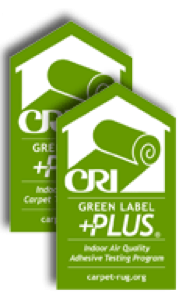Hypoallergenic Carpet and Asthma Issues
Cleaning the Air
Hypoallergenic Carpet can be helpful to those with Asthma issues. It doesn’t matter if you take off your shoes the moment you step in the door. It doesn’t matter if you keep your house spotless — some allergens will make their way inside. (After all, they are nearly invisible.) Once those allergens — dust, pollen, dander, microscopic mold, and other organisms — find their way in, gravity pulls them to the floor. There, they become trapped in and around carpet fibers. Granted, this reduces the opportunity for those nasty little things to circulate in the air, where you can breathe them in and suffer a perpetually runny nose, but every step on that carpet sends tiny clouds of particles back into the air.
Hypoallergenic Carpet
The good news is that people with allergies and asthma can have Hypoallergenic Carpet. Most fibers used in mass-produced rugs and carpets today are harmless materials like polyester and nylon, the same stuff clothes and bags are made out of. These synthetic blends are constructed out of lab-developed fibers that repel allergens, in part because they are nonorganic and offer an inhospitable climate. For example, mold has nothing to eat, and pollen dries out. Nylon is the most effective allergy-controlling carpet fiber. Wool, conversely, should be avoided because allergens and mold can thrive in it. Regardless of material, avoid shag — the shorter the strands, the fewer places the pollen can go. Also, choose a carpet with tightly woven strands for the same reason.
MORE ON CARPETING
Although we might not normally associate carpet with improved indoor air quality, it does have a very positive effect. Gravity causes common household particles, such as dust, pollen, pet and insect dander, to fall to the floor. Carpet fibers trap the particles, removing them from the breathing zone, and reducing their circulation in the air. Proper cleaning with CRI-approved vacuums effectively removes dust and allergens from the carpet and helps keep them out of the air we breathe.
Asthma and Allergies
A misperception is that people with asthma and allergies should avoid carpets in the home. Actually, the opposite is true. Studies have shown that properly cleaned carpet helps reduce symptoms and is the best flooring choice for those dealing with asthma and allergies.
Mold and VOC Misperceptions:
When a carpet is kept clean and dry, mold cannot grow on synthetic fibers. Carpet is recognized as one of the lowest emitters of volatile organic compounds among various flooring choices and interior finishes. The Carpet and Rug Institute’s Green Label Plus Indoor Air Quality Standard identifies carpet, adhesive, and cushion products that meet or exceed government indoor air quality regulations and are the lowest emitting products on the market.
A HEALTHY AND ENVIRONMENTALLY SOUND CHOICE
Carpet Keeps Allergens Out of the Air
There is a misconception that asthma and allergy sufferers should avoid carpet. In fact, the opposite is true. Studies have shown that carpet actually improves indoor air quality. It acts like a trap, keeping dust and allergens out of the air we breathe. Simply put, what falls to the carpet (dust, pet dander, and many other particles) tends to stay trapped until it is removed through vacuuming or extraction cleaning. Smooth floor surfaces allow dust and other allergens to re-circulate into the breathing zone. Additional research
The Lowest Emitter of VOCs
\arpet has the lowest volatile organic compound (VOC) emissions of common flooring choices. In fact, it’s one of the lowest emitting products used in new construction and renovation. What VOCs new carpet emits are short-lived and largely dissipate within 24 to 48 hours – even faster with fresh air ventilation.

CRI’s Green Label Plus standards, which have been adopted across the industry, serve as the benchmark for low VOC emissions. The Green Label Plus symbol indicates:
- The manufacturer voluntarily participates in the program.
The manufacturer is committed to developing ways to minimize any adverse effects on indoor air quality. - A representative sample of the product type is tested by an independent laboratory and meets the established emissions requirements.
Hypoallergenic Carpet Puts You On Safer Ground
Carpets and rugs provide better traction than other flooring options, preventing falls. This is true everywhere, but even more important in areas where there is a lot of rain and snow. And when falls do happen, the softer surface reduces their impact. Whether you are in a business, school, or hospital, fewer falls and less severe injuries are one more reason carpet is a choice you can feel good about.
Less Noise, More Productivity
Carpet is significantly more efficient at reducing noise compared with other flooring. So everyone from employees to students gets a quieter, less distracting environment where they hear more, concentrate better, and perform their best.
FACT: Multiple scientific studies have concluded that carpet fibers, in trapping and immobilizing potential allergy-causing particulates, can actually help people with allergies. If allergens are in the carpet, they’re not circulating in the indoor air stream. Shaw recommends using a HEPA-filter vacuum to remove such particles from the indoor environment fully.
Carpet can help you breathe easier.
Carpet acts as a trap for allergens and can hold significant quantities of soil, dust, and other substances. The carpet holds on to the particles until you are ready to remove them. Regular vacuuming, using a high-efficiency filter and periodic hot-water extractions, removes the majority of allergens. To learn more, check out our Breathe Easier article and a paper, “Carpet, Asthma, and Allergies – Myth or Reality” by Dr. Michael Sauerhoff, Ph.D., DABT.
Does carpet emit harmful chemicals that cause health problems?
FACT: Carpet is one of the lowest emitters of VOCs (volatile organic compounds) among household furnishings and building materials. Shaw carpets meet the industry’s highest VOC standard, the Carpet & Rug Institute’s Green Label Plus program.

